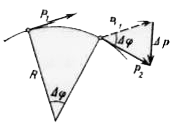A force acts on a particle moving at a relativistic speed in a direction perpendiculal' to its path. How will the particle move? Express the force in terms of the speed and of the radius of curvature of the path.
Text Solution
The correct Answer is:The particle moves in a circle. The expression for the force will be formally the same as in Newtonian mechanics.
Since the force is perpendicular to the path, the magnitude of the momentum does not change (Fig. 6.13). .Tne maghudae of the momentum.s variation is ) . The normal force is

Formally, we have obtained the Fig. 6.13 same result as in the case of the nonrelativistic motion of a particle in a circular path (see 7.2). However, in the relativistic case the expression for the force contains the relativistic mass. Thus, in the particular case the force is perpendicular to the path) the relativistic approach produces formally ihe same result as the classical approach, although in general the second law of Newton in the form F=ma is not valid for relativistic motion.
|
Updated on:21/07/2023
Similar Questions
If the speed of a particle moving at a relativistic speed is doubled, its linear momentum will
View SolutionWhen a charged particle is projected perpendicular to the magnetic field, the force acting on the charged particle is……………of the radius of circular path but…………….the speed of the charged particle.
View Solution
Knowledge Check
- Question 1 - Select One
If the speed of a particle moving at a relativistic speed is doubled, its linear momentum will
ABecome doubleBbocome more than doubleCremain equalDbecome less than double. - Question 2 - Select One
A charged particle is moving in a uniform magnetic field and losses 4% of its KE. The radius of curvature of its path change by
A0.02B0.04C0.1DNone of these - Question 3 - Select One
A particle is moving with a constant speed along a straight line path. A force is not required to
AIncrease its speedBDecrease the momentumCChange the directionDKeep it moving with uniform velocity
A particle moves in a circular path with constant speed . Its motion is
View SolutionA particle is moving with a constant speed along a straight line path. A force is not required to
View SolutionA particle moves in a circular path with a uniform speed. Its motion is
View SolutionA particle moves in a circular path with a uniform speed. Its motion is
View SolutionA particle is moving with a constant speed along a straight line path. A force is not requied to
View Solution

